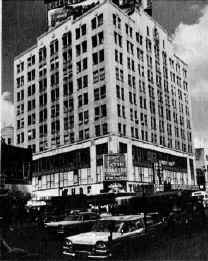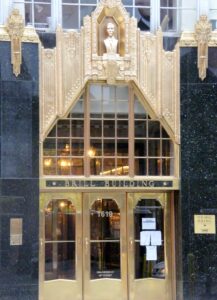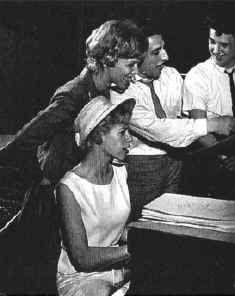 The Brill Building is an office building in Manhattan, just north of Times Square and further uptown from the historic musical Tin Pan Alley neighborhood. After Tin Pan Alley’s luster began to fade this became one of the primary locations in Manhattan for industry offices and studios where some of the most popular American songs of all time were written.
The Brill Building is an office building in Manhattan, just north of Times Square and further uptown from the historic musical Tin Pan Alley neighborhood. After Tin Pan Alley’s luster began to fade this became one of the primary locations in Manhattan for industry offices and studios where some of the most popular American songs of all time were written.
The “Brill Building sound” grew out of the stretch of buildings along Broadway between 49th and 53rd streets. The Brill Building was named after the Brill Brothers whose clothing store was first located in the street level corner. After its completion in 1931, the Depression caused the owners to rent space to music publishers like; Southern Music, Mills Music, and Famous-Music. These publishers were soon joined by many others and by 1962 the Brill Building housed 165 music businesses.
In the early 60s, this building became an exemplar of “vertical integration” that gave birth to a unique type of “assembly line pop”.  This building’s culture enabled a writer to take a new song and make the rounds of publishers until someone bought it. You could then take it and go to another floor and get an arrangement. You could then purchase a lead sheet, then buy some copies at the duplication office; book an hour to make a demo in a studio; then hire some of the vocalists and musicians from among the artists that hung around, and cut a demo of the song. Next, in the same building, you could walk it into publishers offices, record companies. You could even shop the song to an artist’s managers or even artists who may be in the building. When a deal is done you could even negotiate with a radio promoter who could help you promote and sell the record.
This building’s culture enabled a writer to take a new song and make the rounds of publishers until someone bought it. You could then take it and go to another floor and get an arrangement. You could then purchase a lead sheet, then buy some copies at the duplication office; book an hour to make a demo in a studio; then hire some of the vocalists and musicians from among the artists that hung around, and cut a demo of the song. Next, in the same building, you could walk it into publishers offices, record companies. You could even shop the song to an artist’s managers or even artists who may be in the building. When a deal is done you could even negotiate with a radio promoter who could help you promote and sell the record.
The independent music companies in the Brill Building had a creative culture that came to define the influential “Brill Building Sound” and the style of popular songwriting and recording created by its writers and producers. Paul Simon, and Burt Bacharach and many others had offices in the building over time.

Carole King at piano, Cynthia Weil, Barry Mann, Gerry Goffin (L-R)
Carole King described the atmosphere at the publishing houses of the period: “Every day we squeezed into our respective cubby holes with just enough room for a piano, a bench, and maybe a chair for the lyricist if you were lucky. You’d sit there and write and you could hear someone in the next cubby hole composing a song exactly like yours. The pressure in the Brill Building was really terrific—because Donny (Kirshner) would play one songwriter against another. He’d say: “We need a new smash hit”—and we’d all go back and write a song and the next day we’d each audition for Bobby Vee’s producer.”
Donny Kirshner was an example of the key producer/publishers in the building. He was co-owner of the influential New York-based publishing company Aldon Music, which had under contract at various times several of the most important songwriters of the “Brill Building” sound, including Gerry Goffin, Neil Sedaka, Neil Diamond, Paul Simon, Howard Greenfield, Barry Mann, Cynthia Weil and Jack Keller. As a producer-promoter, Kirshner was instrumental in launching the careers of singers and songwriters, like Tony Orlando, Neil Diamond, Carole King, and Sarah Dash of Labelle, as well as discovering a few rock acts, like Kansas. There were a number of other more rock-oriented publishers who helped develop the musical tastes of the 60s.
